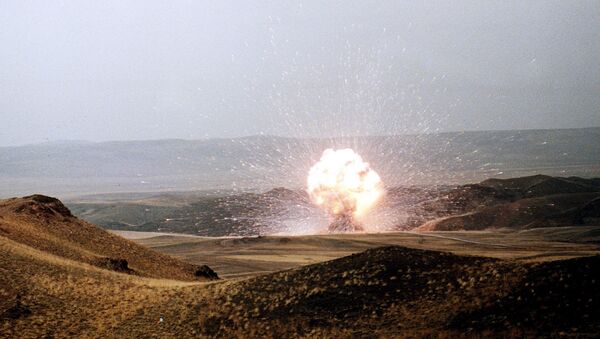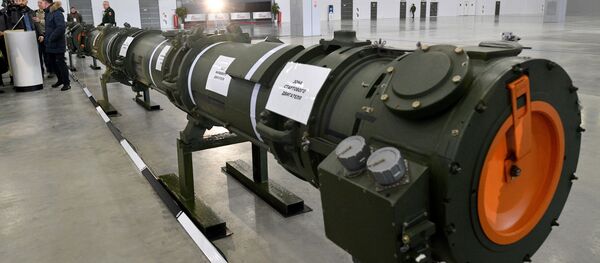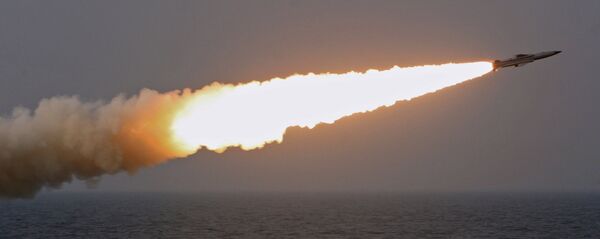US Secretary of State Mike Pompeo announced on 1 February that the United States will suspend its obligations under the INF Treaty on 2 February and will begin a six-month withdrawal process unless Russia comes back into compliance with the bilateral agreement.
The Treaty Between the United States and the Union of Soviet Socialist Republics on the Elimination of Their Intermediate-Range and Shorter-Range Missiles, commonly referred to as the INF, was signed on 8 December 1987, in Washington by then General Secretary of the Communist Party of the Soviet Union Mikhail Gorbachev and then US President Ronald Reagan. The treaty entered into force on 1 June 1988.
READ MORE: Mogherini: EU Doesn't Want Europe to Again Become Region of Superpowers' Rivalry
Under the treaty, the sides pledged not to manufacture, test or deploy medium-range (1,000-5,500 kilometres, or 620-3,420 miles) and short-range (500-1,000 kilometres) ballistic missiles and ground-launched cruise missiles. They also pledged to destroy all launchers and ground-based missiles with a range of 500-5,500 kilometres.
The Soviet Union pledged to destroy Pioneer-type, R-12 and R-14 (SS-20, SS-4 and SS-5) medium-range ballistic missiles, RK-55 (SSC-X-4 Slingshot) ground-launched cruise missiles, as well as the OTR-22 (SS-12M Scaleboard) and OTR-23 Oka (S-23 Spider) short-range ballistic missiles.
The United States pledged to destroy Pershing-2 medium-range ballistic missiles, BGM-109G ground-launched cruise missiles, as well as Pershing-1A short-range ballistic missiles.
The requirements of the treaty were fully carried out by May 1991. The USSR destroyed 1,846 missile systems, with the United States having eliminated 846.
READ MORE: Potential US INF Exit to Raise Instability Created by JCPOA Pullout — ICAN
Missile manufacturing equipment, missile bases, and expert training centres were eliminated as well. The Soviet Union and the United States eliminated a total of 117 and 32 facilities, respectively.
Both sides conducted on-site inspections on compliance with the treaty until 30 May 2001, including permanent inspections at checkpoints of the Votkinsk Engineering Plant in Udmurtia, Russia, and the Hercules Inc. plant in Magna, Utah.
Members of the Special Verification Commission (SVC) reviewed the issues of the treaty’s implementation and coordinating measures to make the treaty more viable and efficient. The commission members had held 29 sessions by October 2003. After that, no sessions took place for a long time since Russia and the United States had by then completed all the projects under the treaty.
On 12 October 2007, Russian President Vladimir Putin met with Russian and US defence and foreign ministers and suggested the introduction of universal INF Treaty obligations. The United States supported the proposal.
READ MORE: Moscow: Russian Hypersonic Weapons Eliminate Threat From US Exit From INF Treaty
On 12 February 2008, Russian Foreign Minister Sergei Lavrov spoke at a plenary session of the Disarmament Conference in Geneva and suggested to jointly search for optimal methods to advance the above-mentioned initiative. Lavrov also submitted a draft document on the main provisions of an agreement on the elimination of ground-based medium-range and short-range missiles in accordance with international law. Despite Russia’s efforts, this initiative was never implemented.
Since 2013, the United States has been accusing Russia of violating the INF Treaty. Washington has accused Moscow of testing and deploying the 9M729 ground-launched cruise missile, claiming it has a range of over 500 kilometres, and thus violating the INF Treaty. Russia has denied these allegations. The US, for its part, has declined to specify the circumstances that formed the basis of their claims.
Russia has stated that the United States is the one that violated the INF Treaty by an unlawful unilateral withdrawal of armed drones (which meet the definition "ground-based cruise missile" in the treaty) at a range beyond the limit set by the INF Treaty; maintenance of a technological capability of medium- and short-range ground-based missiles by testing it on a wide range of target missiles during tests declared as anti-missile; ground deployment of the Aegis Ashore MK-41 missile launching systems, which can be used to launch Tomahawk long-range cruise missiles and other attack missile systems, at European facilities of the US global missile defence system.
The concerns of the parties have been repeatedly discussed at various levels in a bilateral format. On 15-16 November 2016, both sides convened a session of the Special Verification Commission whose members had not met since 2003. Another session of the SVC took place on 12-14 December 2017. However, no progress has been achieved on any of the problematic issues.
READ MORE: Next US President May Be Interested in Reviving INF Treaty — Ex-US Official
Members of the US Congress have repeatedly called for drafting a bill that would directly accuse Russia of violating the treaty and would pave the way for the US withdrawal from it along the same lines as from the Anti-Ballistic Missile (ABM) treaty.
On 4 December 2018, US Secretary of State Mike Pompeo gave Russia two months to return to compliance with the INF Treaty or the United States would suspend its obligations under the treaty and leave the accord on 2 February. The Russian authorities, in turn, have many times stressed that their country is in strict compliance with the obligations outlined in the treaty.
Reacting to that, Russian Security Council Secretary Nikolai Patrushev said that the test range of the 9M729 missile did not exceed 476 kilometres, which does not exceed the acceptable 500-kilometre treaty limit.
Consultations in Geneva
On 15 January 2019, Russia and the United States held consultations on the INF Treaty in Geneva. During the meeting, the United States demanded the destruction of the Russian 9M729 missile system.
Russia declared that it was ready to provide transparency on the 9M729 missile, but in response, Washington should take into account Moscow's concerns. According to Russian Deputy Foreign Minister Sergei Ryabkov, these concerns involve the use of assault drones and the deployment of Mk 41 launching systems, which are capable of launching Tomahawk cruise missiles in Europe in violation of the INF Treaty.








